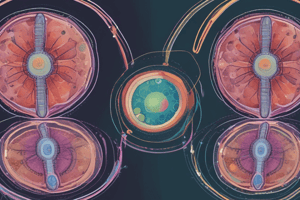Podcast
Questions and Answers
What is the main purpose of mitosis?
What is the main purpose of mitosis?
- Genetic diversity
- Formation of gametes
- Reduction of chromosome number
- Growth and tissue repair (correct)
Meiosis produces two identical diploid cells.
Meiosis produces two identical diploid cells.
False (B)
What occurs during crossing over in meiosis?
What occurs during crossing over in meiosis?
Exchanging genetic material between homologous chromatids
In mitosis, daughter cells are __________ of the parent cell.
In mitosis, daughter cells are __________ of the parent cell.
During which stage do chromosomes align at the metaphase plate in mitosis?
During which stage do chromosomes align at the metaphase plate in mitosis?
Match the following stages with their descriptions:
Match the following stages with their descriptions:
Genetic variation occurs during mitosis.
Genetic variation occurs during mitosis.
In meiosis, the chromosome number is __________ in the resulting cells.
In meiosis, the chromosome number is __________ in the resulting cells.
Flashcards
Mitosis
Mitosis
A type of cell division producing two identical daughter cells from one parent cell.
Daughter Cells (Mitosis)
Daughter Cells (Mitosis)
Two genetically identical cells resulting from mitosis.
Meiosis
Meiosis
Cell division creating four genetically diverse haploid cells from one parent cell.
Haploid Cells
Haploid Cells
Signup and view all the flashcards
Crossing Over
Crossing Over
Signup and view all the flashcards
Independent Assortment
Independent Assortment
Signup and view all the flashcards
Chromosome Condensation
Chromosome Condensation
Signup and view all the flashcards
Genetic Variation (Meiosis)
Genetic Variation (Meiosis)
Signup and view all the flashcards
Study Notes
Mitosis
- Mitosis is cell division producing two identical daughter cells from one parent cell
- Purpose: Growth, repair, asexual reproduction
- Location: Somatic (body) cells
- Daughter cells: Two identical diploid cells (same chromosome number as parent)
- Chromosome number: Maintained
- Genetic variation: None (clones of parent)
- Stages (PMAT):
- Prophase: Chromosomes condense, nuclear envelope breaks down, spindle fibers form.
- Metaphase: Chromosomes align at metaphase plate, spindle fibers attach to centromeres.
- Anaphase: Sister chromatids separate and move to opposite poles.
- Telophase: Nuclear envelopes reform, chromosomes decondense, spindle fibers disappear.
- Cytokinesis: Division of the cytoplasm, forming two separate cells.
Meiosis
- Meiosis is cell division reducing chromosome number by half to produce four genetically diverse haploid cells.
- Purpose: Gamete (sperm and egg) formation
- Location: Germ cells (reproductive organs)
- Daughter cells: Four non-identical haploid cells.
- Chromosome number: Halved (haploid)
- Genetic variation: High (crossing over and independent assortment)
- Stages:
- Meiosis I (Reductional division):
- Prophase I: Chromosomes condense, pair up (tetrads), crossing over occurs, nuclear envelope breaks down.
- Metaphase I: Homologous pairs align at metaphase plate, Independent assortment occurs.
- Anaphase I: Homologous chromosomes separate.
- Telophase I: Nuclear envelopes may reform, cytokinesis forms two haploid cells.
- Meiosis II (Equational division):
- Prophase II: Chromosomes condense (if decondensed after Meiosis I), nuclear envelope breaks down (if reformed).
- Metaphase II: Chromosomes align at metaphase plate.
- Anaphase II: Sister chromatids separate.
- Telophase II: Nuclear envelopes reform, cytokinesis produces four haploid cells.
- Meiosis I (Reductional division):
Mitosis vs. Meiosis
| Feature | Mitosis | Meiosis |
|---|---|---|
| Purpose | Growth, repair, asexual reproduction | Gamete production, genetic diversity |
| Location | Somatic cells | Germ cells |
| Number of divisions | One | Two |
| Daughter cells | Two identical diploid cells | Four non-identical haploid cells |
| Chromosome number | Maintained | Halved |
| Genetic variation | None | High (crossing over, independent assortment) |
Studying That Suits You
Use AI to generate personalized quizzes and flashcards to suit your learning preferences.





